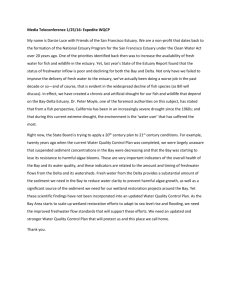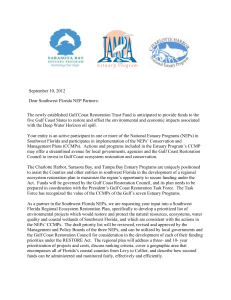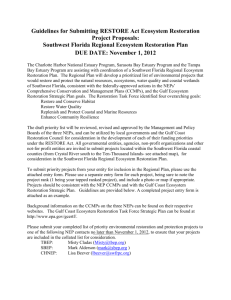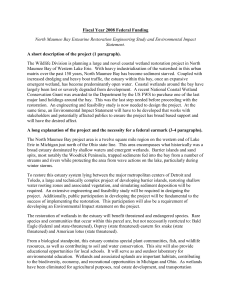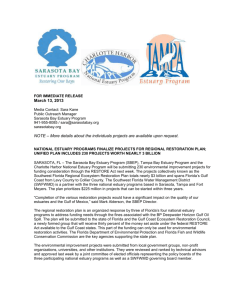FINAL YR3PreproposalGuidelines
advertisement
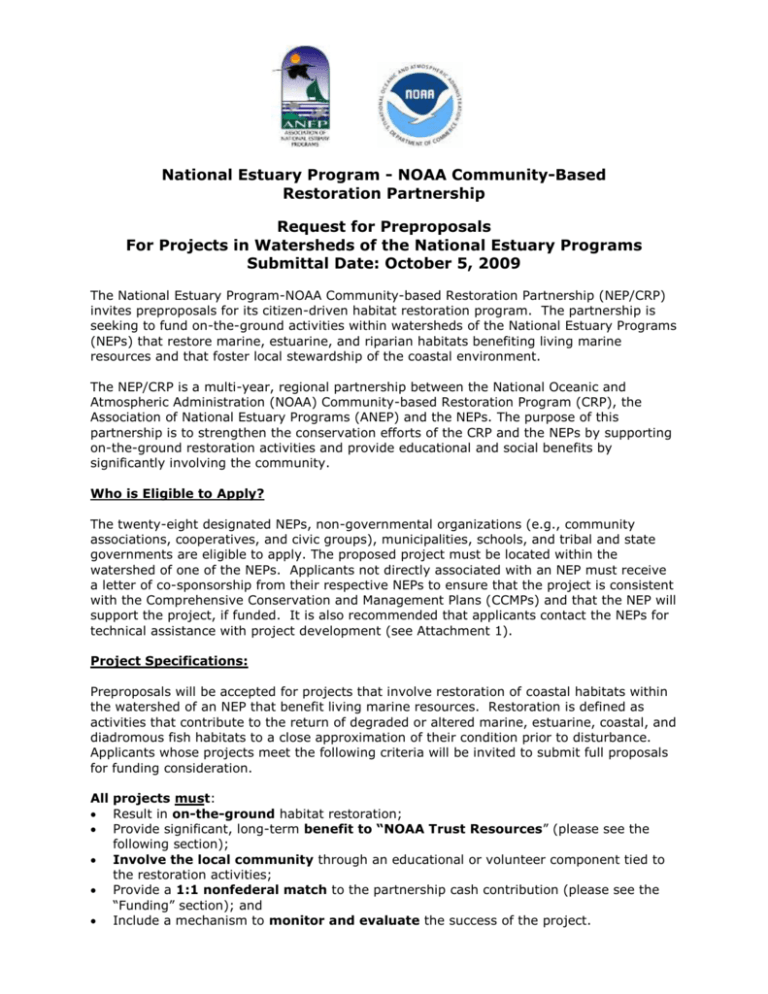
National Estuary Program - NOAA Community-Based Restoration Partnership Request for Preproposals For Projects in Watersheds of the National Estuary Programs Submittal Date: October 5, 2009 The National Estuary Program-NOAA Community-based Restoration Partnership (NEP/CRP) invites preproposals for its citizen-driven habitat restoration program. The partnership is seeking to fund on-the-ground activities within watersheds of the National Estuary Programs (NEPs) that restore marine, estuarine, and riparian habitats benefiting living marine resources and that foster local stewardship of the coastal environment. The NEP/CRP is a multi-year, regional partnership between the National Oceanic and Atmospheric Administration (NOAA) Community-based Restoration Program (CRP), the Association of National Estuary Programs (ANEP) and the NEPs. The purpose of this partnership is to strengthen the conservation efforts of the CRP and the NEPs by supporting on-the-ground restoration activities and provide educational and social benefits by significantly involving the community. Who is Eligible to Apply? The twenty-eight designated NEPs, non-governmental organizations (e.g., community associations, cooperatives, and civic groups), municipalities, schools, and tribal and state governments are eligible to apply. The proposed project must be located within the watershed of one of the NEPs. Applicants not directly associated with an NEP must receive a letter of co-sponsorship from their respective NEPs to ensure that the project is consistent with the Comprehensive Conservation and Management Plans (CCMPs) and that the NEP will support the project, if funded. It is also recommended that applicants contact the NEPs for technical assistance with project development (see Attachment 1). Project Specifications: Preproposals will be accepted for projects that involve restoration of coastal habitats within the watershed of an NEP that benefit living marine resources. Restoration is defined as activities that contribute to the return of degraded or altered marine, estuarine, coastal, and diadromous fish habitats to a close approximation of their condition prior to disturbance. Applicants whose projects meet the following criteria will be invited to submit full proposals for funding consideration. All projects must: Result in on-the-ground habitat restoration; Provide significant, long-term benefit to “NOAA Trust Resources” (please see the following section); Involve the local community through an educational or volunteer component tied to the restoration activities; Provide a 1:1 nonfederal match to the partnership cash contribution (please see the “Funding” section); and Include a mechanism to monitor and evaluate the success of the project. The goal of the NEP/CRP partnership for 2010 is to fund 4 to 6 projects that will yield tangible results in habitat restoration and significant involvement by the public. Projects that emphasize on-the-ground restoration activities, therefore, will be given priority. Project elements may also include workshops, monitoring, or other such activities which directly support actual and measurable habitat improvement and/or public education about the project. Recognizing that restoration is a multi-faceted effort, funding for projects involving limited pre-implementation activities, such as engineering and design and shortterm baseline studies, will be considered. However, funding for such activities will be limited to 15% of the total project cost. With the goal to implement on-the-ground projects and due to limited funding, projects consisting solely of engineering and design components will not be considered by the partnership this year. Projects emphasizing a single component, such as only outreach or program coordination, propose to expand an organization’s day-to-day activities, or that primarily seek support for administration, salaries, overhead, and/or travel will not be accepted. NOAA Trust Resources: NOAA trust resources and the habitats that support them serve as the focus of this partnership. Applicants must demonstrate that habitat restoration will result in a benefit to one or more of the following NOAA trust resources. Commercial and recreational fishery resources (marine fish and shellfish and their habitats); Diadromous species (species with life cycles that carry them between rivers and oceans, such as salmon, striped bass and American eel); Endangered and threatened marine species and their habitats; Marine mammals, turtles, and their habitats; Marshes, mangroves, seagrass beds, coral reefs, and other coastal habitats; and Resources associated with National Marine Sanctuaries and National Estuarine Research Reserves. Funding: Preproposals will be evaluated and selected by the NEP/CRP steering committee, which consists of directors of the NEPs and NOAA CRP staff. Approximately $124,000 is available for Year 2010 projects. Project funding levels will typically fall within the range of $15,000 $30,000. All projects must provide a 1:1 match of the grant amount. Matching funds cannot be federal dollars. Matching funds can be cash and/or in-kind sources that are incurred during the project period, including one or more of the following: In-kind donations, such as labor, materials and earthmoving equipment; Technical assistance for restoration site selection, design, and evaluation; Workforce support or other in-kind services, especially those that promote citizens’ hands-on involvement; Local stewardship and monitoring to sustain and evaluate the success of the restoration over time. Additional federal funding or other contributions may be included in the project description to demonstrate that the project is part of a larger restoration effort. However, such federal contributions may not serve as matching contribution to the NEP/CRP funds. 2 Minimum Monitoring/Evaluating Requirements: All applicants should include quantitative, science-based restoration monitoring for projects. NOAA, in accordance with the Estuary Restoration Act of 2000, supports the development of monitoring plans that include one structural and one functional monitoring parameter. Applicants are encouraged to use the Restoration Monitoring Planner at http://habitat.noaa.gov/restoration/rmp/ when developing monitoring plans or contact NOAA CRP staff at http://www.nmfs.noaa.gov/habitat/restoration/contact.html for further assistance. ** Please note that this monitoring plan is not required for the preproposal, but will be required for all NEP/CRP applicants invited to submit full proposals. Preproposal Requirements: Preproposals must be received by October 5, 2009 and should be no more than two (2) pages in length. Preproposals must include all of the information requested and be formatted as shown in Attachment 2. Attachments and appendices are not included in this maximum page requirement. Applicants not directly associated with an NEP must receive a letter of co-sponsorship from their respective NEPs to ensure that the project is consistent with the CCMPs and has the support of the NEP and include it as an attachment to the preproposal. Timelines may use a February 1, 2010, starting date, but the actual start date will be determined by completion of the grant agreement document. Projects should be competed within 18 months of receiving an award. Projects that meet the minimum partnership requirements will be invited to submit full proposals (approximate submittal date: November 20, 2009) that will more fully describe the activities to be accomplished and will include a specific timeline, a monitoring plan, and a detailed budget. Final projects will be selected for funding following review by the NEP/CRP Steering Committee. Preproposal Submission: Applicants must submit a digital copy via e-mail or mail a hard copy, including a CD of the proposal. Documents MUST be in MS Word with photos as low resolution .jpg files. The digital copy, whether submitted via e-mail or a mailed disk must be received by the due date. Materials will not be accepted via fax. Please submit materials to: (Use Headline “NEP/CRP Project Submission”) Ms. Lore H. O’Hanlon 1110 Raintree Drive Charlottesville, VA 22901 ecolore@aol.com 3 ATTACHMENT 1 CONTACT FOR NEP/CRP ASSISTANCE I. For questions about the application process, please contact: Ms. Lore H. O’Hanlon, NEP/CRP Partnership Manager at 434-964-1968 or ecolore@aol.com II. For technical questions and assistance from the NEPs Albemarle-Pamlico NEP – Bill Crowell, Director 1601 Mail Service Center Raleigh, NC 27699-1601 Phone: (919) 715-1327 bill.crowell@ncmail.net www.apnep.org Barataria-Terrebonne Estuary Program - Kerry St. Pe, Director Nicholls State University Campus P.O. Box 2663 Thibodaux, LA 70310 Phone: (985) 447-0868; toll free (800) 259-0869 kerry@btnep.org www.btnep.org Barnegat Bay National Estuary Program - Stanton Hales, Ph.D., Director Ocean County College P.O. Box 2001 Toms River, NJ 08754 Phone: (732) 255-0472 shales@ocean.edu www.bbep.org Buzzards Bay National Estuary Program - Dr. Joe Costa, Executive Director 2870 Cranberry Highway E. Wareham, MA 02538 Phone: (508) 291-3625;ext 19 jcosta@buzzardsbay.org www.buzzardsbay.org Casco Bay Estuary Partnership – Curtis Bolhen, Director USM Muskie School P.O. Box 9300 34 Bedford St. Portland, ME 04101-9300 Phone: (207) 780-4820 cbohlen@usm.maine.edu www.cascobayestuary.org 4 Charlotte Harbor National Estuary Program - Dr. Lisa Beever, Director 1926 Victoria Ave Fort Myers, FL 33901-3414 Phone: (239) 338-2556 ext. 235; toll free (866) 835-5785 lbeever@swfrpc.org www.chnep.org Coastal Bend Bays and Estuaries Program - Ray Allen, Executive Director 1305 N. Shoreline Blvd., Suite 205 Corpus Christi, TX 78401 Phone: (361) 885-6204 rallen@cbbep.org www.cbbep.org Partnership for the Delaware Estuary – Jennifer A. Adkins, Executive Director One Riverwalk Plaza 110 South Poplar Street, Suite 202 Wilmington, DE 19801 Phone: 800-445-4935; (302) 655-4990 JAdkins@DelawareEstuary.org www.delawareestuary.org Delaware Inland Bays Estuary Program - Ed Lewandowski, Executive Director 38375 Inlet Road Rehobeth Beach, DE 19971 302-226-8105 director@inlandbays.org www.inlandbays.org Galveston Bay Estuary Program - Helen E. Drummond, Director 17041 El Camino Real, Ste. 210 Houston, Texas 77058 (281) 218-6461 hdrummon@tceq.state.tx.us www.gbep.state.tx.us Indian River Lagoon NEP - Troy Rice, Director St. Johns River WMD 525 Community College Parkway, SE Palm Bay, FL 32909 Phone: (321) 984-4938 trice@sjrwmd.com www.itsyourlagoon.com Long Island Sound Study - Mark Tedesco, Director U.S. EPA, Long Island Sound Office Stamford Government Center 888 Washington Boulevard Suite 6-5 Stamford, CT 06904-2152 Phone: (203) 977-1541 tedesco.mark@epa.gov www.longislandsoundstudy.net 5 Lower Columbia River Estuary Partnership - Debrah Marriott, Executive Director 811 SW Naito Parkway, Suite 120 Portland, OR 97204 Phone: (503) 226-1565 marriott@lcrep.org www.lcrep.org Maryland Coastal Bays Program – Dave Wilson, Director 9919 Stephen Decatur Highway – Suite 4 Ocean City, MD 21842 Phone: (410) 213-2297 dwilson@mdcoatalbays.org www.mdcoastalbays.org Massachusetts Bays NEP – Jay Baker, Executive Director 251 Causeway Street, Suite 800 Boston, MA 02114 Phone: (617) 626-1204 Jason.baker@state.ma.us www.mass.gov/envir/massbays Mobile Bay Estuary Program – Roberta Swann, Acting Director Mobile Bay Estuary Program 4172 Commanders Drive Mobile, AL 36615 Phone: (251) 431-6409 rswann@mobilebaynep.com www.mobilebaynep.com Morro Bay National Estuary Program - Dan Berman, Director 601 Embarcadero, Suite 11 Morro Bay, CA 93442 Phone: (805) 772-3834 dberman@mbnep.org www.mbnep.org Narragansett Bay Estuary Program - Richard Ribb, Director Box 27, URI Bay Campus Narragansett, RI 02882 Phone: (401) 874-6233 rribb@gso.uri.edu www.nbep.org Piscataqua Region Estuaries Partnership - Jennifer Hunter, Director Piscataqua Region Estuaries Partnership University of New Hampshire Nesmith Hall, 131 Main Street Durham, NH 03824 Phone: (603) 862-3948 jennifer.hunter@unh.edu www.prep.unh.edu 6 NY-NJ Harbor Estuary Program - Robert M. Nyman, Director New York-New Jersey Harbor Estuary Program Office U.S. Environmental Protection Agency 290 Broadway, 24th Floor New York, NY 10007-1866 Phone: (212) 637-3816 nyman.robert@epa.gov www.harborestuary.org Peconic Estuary Program - Vito Minei, Director SCDHS-Office of Ecology 360 Yaphank Avenue Suite 2B Yaphank, NY 11980 Phone: (631) 853-3082 vito.minei@co.suffolk.ny.us www.peconicestuary.org Puget Sound Partnership– David Dicks, Executive Director P.O. Box 40900 Olympia WA 98504-0900 Phone: (360) 725-5454; toll free (800) 54-SOUND David.Dicks@psp.wa.gov www.psp.wa.gov San Francisco Estuary Project – Judy Kelly, Program Manager 1515 Clay Street, Suite 1400 Oakland, CA 94612 Phone: (510) 622-8137 JAKelly@waterboards.ca.gov http://sfep.abag.ca.gov San Juan Bay Estuary Partnership -Javier Laureano, Executive Director P.O Box 9509 San Juan, PR 00908-9509 Phone: (787) 725-8165 jlaureano@estuario.org www.estuario.org Santa Monica Bay Restoration Commission – Shelley Luce, Executive Director Santa Monica Bay Restoration Commission 320 W. 4th Street, Suite 200 Los Angeles, CA 90013 Phone: (310) 216-9827 SLUCE@santamonicabay.org www.santamonicabay.org Sarasota Bay Estuary Program - Mark Alderson, Director 111 South Orange Avenue, Suite 200W Sarasota, FL 34236 Phone: (941) 955-8085 mark@sarasotabay.org www.sarasotabay.org 7 Tampa Bay Estuary Program – Holly Greening, Director 100 8th Avenue, S.E. MS I-1/NEP St. Petersburg, FL 33701 Phone: (727) 893-2765 ext. 202 hgreening@tbep.org www.tbep.org Tillamook Estuaries Partnership – Lisa Phipps, Executive Director P.O. Box 493 613 Commercial Drive Garibaldi, OR 97118 Phone: (503) 322-2222 lphipps@tbnep.org www.tbnep.org 8 Attachment 2 Preproposal Format Please submit the following information using this format and these headings. Add the required information after each heading. I. Applicant Information 1. Organization 2. Address of Organization 3. Organization Web Page Address II. Project Contact 1. 2. 3. 4. 5. 6. 7. III. Project Manager and Title Address of Contact (if different from above) Phone number Fax number Email address Contact web page address Congressional District Project Information 1. 2. 3. 4. 5. 6. 7. Project name Project start date Project end date Project location (City, County, State) Land Ownership (public/private) Type(s) of habitat (marsh, reef, seagrass bed, etc.) NOAA Trust Resource(s) to benefit from restoration (Common and scientific name) 8. Partners involved 9. Federal, state or local permits required (Note: Documentation that all required permits are obtained must be provided prior to expenditure of funds under this partnership) IV. Project Abstract 1. Project objectives (100 words maximum) – specify only those objectives to be accomplished with this funding 2. Description of project to be completed with this funding (250 words maximum) 3. If the project is part of a larger regional and/or local effort, briefly describe this effort 4. Describe the specific on-the-ground activities to be undertaken to achieve project objectives 5. Describe project partners and their contribution 6. Describe the community involvement through an educational and/or volunteer component 9 V. Budget 1. Amount of NEP/CRP Partnership funds requested. Include a brief budget narrative explaining what these funds will be used for. 2. Matching Contributions – Clearly specify sources and types of contributions, both in-kind and cash, and what the matching funds will be used for. Federal funds CANNOT be used for match (Calculate volunteer hours at $20/hr.). 3. Budgeted line item expenditures (e.g., salaries, equipment, supplies, contractual services Partnership Request Amount and Source of Funding Match* Personnel Staff Volunteers Fringe Benefits Travel Equipment Supplies Contractual Construction Other (specify) Total Direct Charges Total Indirect Charges ** TOTAL BUDGET * Indicate whether funding is confirmed or pending ** Indirect charges are limited to 15% of the NEP/CRP Partnership grant award. VI. Supplemental Information 1. Diagram or photo of project site depicting scale, position in landscape, and other details of project. 2. Letter of co-sponsorship from the appropriate NEP, if applicable. 3. Note: Applicants invited to send full proposals will need to provide sufficient project specific information to allow NOAA to complete a NEPA analysis on the proposed project in order to be selected for funding. 10

